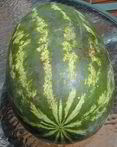Watermelon: Citrullus lanatus

Sugar Bowl Hybrid: The sweetest, best-tasting watermelon you could ever grow. 20-25 lbs. melons are distinctively striped on the outside and distinctively bright red, juicy and delicious on the inside.
Germinates: 7-14 days Harvest: 82 days Grown in: Full Sun
Nutrition Facts: Germination:
How to Pick Fresh Watermelon:
When picking out fresh watermelon, you want to be on the lookout for a few key things. Learn how to pick fresh watermelon with help from Zenin. Picking a sweet watermelon means picking one that has had sufficient time to ripen on the vine and therefore sweeten, without becoming overly ripe and mushy. The Old Farmer's Almanac of thumping on a watermelon until you find one with a dull thud is not the best way to determine which watermelons are ripe and which are not. Rather, carefully examine the watermelons and make a couple observations. Whether you are in the field harvesting your own watermelons or at the market or grocery store, if a watermelon "passes" all these observations, chances are it is a sweet, ready to eat watermelon:
1-Look for a brightly colored watermelon rind. This often indicates the watermelon hasn't been away from the patch for many days. Depending on the type of watermelon, the rind may be a light color. For traditional seeded watermelons, a dark green color often indicates the melon's ripeness. Watch for the watermelon's surface color to become dull.
2-Check the watermelon's ground spot. This is the yellowish or orange spot on the underside of the melon that indicates how long the melon sat in the field maturing. A green spot indicates the melon didn't ripen on the vine and may not be as sweet. Also, check the stem and tendrils of the watermelon and wait for them to curl, turn brown and become dry.
3-Choose a symmetrical watermelon. If the rind has an odd shape, this may indicate the melon lacked water at some point in its growing season. This may affect its juiciness. While the watermelon rind may have some scratches from transit that won't hurt its flavor, avoid melons with major flaws. Press on the skin of the watermelon. It's ready when the skin is resistant and rough feeling.
4-Pick up individual watermelons of a similar size to compare their weights. The heaviest melon is going to have the most juice. Watermelons are at least 92 percent water, so choose the heaviest melon you can for the juiciest selection.
5-Select a watermelon from an unrefrigerated crate rather than a refrigerated one to have more lycopene and carotenoid nutrients available. While you may refrigerate the melon when you cut it and prior to serving it, once you cut the melon its nutrient level begins to decrease.
Germinates: 7-14 days Harvest: 82 days Grown in: Full Sun
Nutrition Facts: Germination:
How to Pick Fresh Watermelon:
When picking out fresh watermelon, you want to be on the lookout for a few key things. Learn how to pick fresh watermelon with help from Zenin. Picking a sweet watermelon means picking one that has had sufficient time to ripen on the vine and therefore sweeten, without becoming overly ripe and mushy. The Old Farmer's Almanac of thumping on a watermelon until you find one with a dull thud is not the best way to determine which watermelons are ripe and which are not. Rather, carefully examine the watermelons and make a couple observations. Whether you are in the field harvesting your own watermelons or at the market or grocery store, if a watermelon "passes" all these observations, chances are it is a sweet, ready to eat watermelon:
1-Look for a brightly colored watermelon rind. This often indicates the watermelon hasn't been away from the patch for many days. Depending on the type of watermelon, the rind may be a light color. For traditional seeded watermelons, a dark green color often indicates the melon's ripeness. Watch for the watermelon's surface color to become dull.
2-Check the watermelon's ground spot. This is the yellowish or orange spot on the underside of the melon that indicates how long the melon sat in the field maturing. A green spot indicates the melon didn't ripen on the vine and may not be as sweet. Also, check the stem and tendrils of the watermelon and wait for them to curl, turn brown and become dry.
3-Choose a symmetrical watermelon. If the rind has an odd shape, this may indicate the melon lacked water at some point in its growing season. This may affect its juiciness. While the watermelon rind may have some scratches from transit that won't hurt its flavor, avoid melons with major flaws. Press on the skin of the watermelon. It's ready when the skin is resistant and rough feeling.
4-Pick up individual watermelons of a similar size to compare their weights. The heaviest melon is going to have the most juice. Watermelons are at least 92 percent water, so choose the heaviest melon you can for the juiciest selection.
5-Select a watermelon from an unrefrigerated crate rather than a refrigerated one to have more lycopene and carotenoid nutrients available. While you may refrigerate the melon when you cut it and prior to serving it, once you cut the melon its nutrient level begins to decrease.
